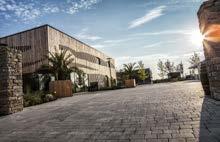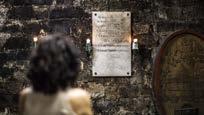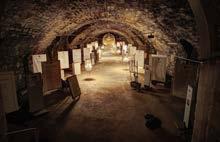
9 minute read
Württemberg
RED WINE COUNTRY IN THE SOUTH
Württemberg, with 11,500 ha (28,416 acres) of vines, is Germany’s fourth largest wine-growing region and one of the few to produce more red wine than white. More than 70% of its vineyard area is planted with red wine grapes, above all the ever-popular Trollinger grape. Indeed, easy-to-drink Trollinger has been dubbed the “national drink of Württemberg,” and is consumed often and with gusto with hearty platters of cold cuts. It’s no secret that per capita wine consumption in Württemberg is considerably higher than elsewhere – Trollinger consumption doubtlessly plays a role – not least after the annual Trollinger Marathon in Heilbronn. Württemberg’s other important red wine grapes are Schwarzriesling (Pinot Meunier), Lemberger and Spätburgunder (Pinot Noir) – wines most often selected to add pleasure to upscale dining occasions. Popular summer specialties include the rosé-like
Advertisement

“Schillerwein” (red and white grapes are pressed and fermented together), as well as Riesling, the region’s most important white variety.
württemberg’s growers cultivate grapes along the Neckar river, but also in the protected valleys of its tributaries (rems, enz, Kocher, Jagst and Tauber) and near the Bodensee (Lake Constance). The württembergisches Unterland district in the central Neckar Valley forms the heart of the region, bordered to the south by the remstal-Stuttgart district.
A high proportion of the vineyards are steep. Many growers own only small parcels of vines and traditionally deliver their crop to the nearest wine cooperative to make and market the wine. There are more than 50 cooperatives in württemberg and they market about 80 percent of the region’s wine.

The württemberg wine road covers much of the region along the Neckar and its side valleys as it winds its way some 500 km (310 miles) from weikersheim, near Bad Mergentheim, to Metzingen, east of Tübingen. württemberg’s annual wine festival calendar lists more than 200 great opportunities for becoming acquainted with the local wines in atmospheric settings. Two of the region’s largest festivals take place between late August and mid-September in Stuttgart and Heilbronn.
Last but not least: württemberg sees itself as the land of philosophers and poets. The first president of the federal republic is said to have been inspired by a glass of Lemberger when writing his speeches. Schiller and Hölderlin also probably found inspiration in württemberg wine. A wine trip to württemberg without art and culture is unthinkable. A visit to the Schiller National Museum in the Swabian town of Marbach is worth a detour, for example, as is a visit to Götz von Berlichingen’s Burg Hornberg.
WÜRTTEMBERG –AT A GLANCE
Geographical location: The region extends from Bad Mergentheim in the Tauber Valley to reutlingen, south of Tübingen · Main wine centers: Stuttgart and Heilbronn · Climate: Mild average temperatures; valley of the Neckar river is protected by the hills of the Black Forest and Swabian Alb · Soils: Various marl formations; in the central Neckar area, patches of shell-limestone · Size: ca. 11,500 ha (28,416 acres) · Grape varieties: Trollinger, riesling, Lemberger, Schwarzriesling (Pinot Meunier), Spätburgunder (Pinot Noir)
Information: Werbegemeinschaft Württembergischer Weingärtnergenossenschaften e G raiffeisenstraße 6 71696 Möglingen Tel. +49 (0)7141 2446-0 Fax +49 (0)7141 2446-20 www.wwg.de info@wwg.de
Weinbauverband Württemberg e. V. Hirschbergstraße 2 74189 weinsberg Tel. +49 (0)7134 8091 Fax +49 (0)7134 8917 www.weinbauverband-wuerttemberg.de info@weinbauverband-wuerttemberg.de
Württemberg: Landmarks of German Wine Culture
WINZERHOF GIERER ON LAKE CONSTANCE, WÜRTTEMBERG
For over 300 years, the Gierer family of winemakers has been producing wine on the sun-kissed northern shore of Lake Constance. Yet, all manners of retired tools – from horse collars to a wine press – had to make way for the new entry area to the tasting room. The unconventionally designed addition incorporates the estate's old wooden barrel cellar while maintaining a contemporary face. angular lines and transparent facades, the new tasting room combines regional materials and extraordinary shapes with fantastic sightlines in both directions – not just from the inside out over the surroundings near and far, but also into the cellar where the estate's wines are maturing. Facing north, the glass wall directs the gaze toward the vineyards. Looking in the other direction, the view toward the entryway sweeps over Lake Constance, toward the Alps. And the barrique cellar below the shed can be observed when walking on a glass floor in the presentation area. It would be hard to imagine a more perfect setting to taste the estate's wines: Müller-Thurgau, riesling, Grauburgunder (Pinot Gris), Sauvignon Blanc and Bacchus, Spätburgunder (Pinot Noir) and dornfelder, weißherbst and rotling, a specialty of the Lake Constance region.
Winzerhof Gierer Nonnenhorn, Sonnenbichlstraße 31 Tel. +49 (0)8382 89581
Enchanting Sightlines, Inside and Out with its front wall made of Vasler quartzite, strikingly www.winzerhof-gierer.de

KELLEREI WILHELM KERN IN REMSTAL, WÜRTTEMBERG
“There is a clarity to our wines, and to us, that we see reflected in our estate as well,” notes the Kern Family of Weingut Wilhelm Kern in Kernen-Rommelshausen. Buying in harvested grapes – Kerner, Riesling, Silvaner, the Pinot trio, Zweigelt, Lemberger and of course Trollinger – from over 150 winegrowers throughout Württemberg, the family makes high-quality wines rooted in the region.
Kern, Kerner, Kernen It all started in downtown Stuttgart, where in 1903 wilhelm Kern opened a cooperage alongside his winery and retail store. over the course of the post-world war II boom, the Kerns secured more space for their flourishing business by relocating their headquarters to Fellbach-Schmiden, northeast of the Stuttgart city line. In 2012, following another period of corporate growth, it relocated its headquarters again. Today the winery in Kernen-rommelshausen greets visitors as a modern cube, completely clad in larch wood. dynamically curved openings reminiscent of the silhouette of a hilly vineyard landscape break up the monolithic character of the facades. The prevailing quiet and relaxed atmosphere allows visitors to concentrate on the estate's wines. After all, the Kerns believe, “the vineyards in their diverse and charming environment are the capital and foundation upon which we are designing our future.”
Kellerei Wilhelm Kern Kernen-rommelshausen, wilhelm-Maybach-Straße 25 Tel. +49 (0)7151 2766790 www.kern-weine.de
SEKTMANUFAKTUR KESSLER IN ESSLINGEN, WÜRTTEMBERG
“Wie lieb und luftig perlt die Blase/der Witwe Klicko in dem Glase” (How fine and lovely the bubbles' salute/to Widow Klicko in her flute), rhymed Wilhelm Busch in his picture book titled “Helen Who Couldn't Help It.” This may well have been Georg Christian Kessler's thoughts as well, for the founder of Germany's oldest Sekt maker learned the high art of producing sparkling wine in Champagne – specifically, at the Veuve Clicquot-Ponsardin winery in Reims.
Württemberg Bubbles, Champagne Style The merchant from Heilbronn impressed many people during his meteoric rise, and widow Barbe-Nicole Clicquot personally named him as heir to her Champagne empire. Yet it was somehow not meant to be. Kessler instead ended up returning to his native württemberg and in 1826 founded G. C. Kessler & Compagnie, in esslingen. working in the former press house of the Kaisheimer Pfleghof below the esslinger Burg castle, he produced the first 4,000 bottles of

“sparkling württemberg wine” from Frühburgunder grapes (Pinot Noir Précoce) using the techniques he had learned in Champagne. The glass bottles of that time couldn't always withstand the extreme pressure from secondary fermentation, meaning that sparkling wine production was a somewhat risky proposition. Kessler's company soared, however, and in 1832 he saw fit to relocate the company's headquarters to its current location: the Kesslerhaus in the former Speyrer Zehnthof at esslingen's marketplace. Its southern section was renamed Georg-Christian-von-Kessler-Platz in 2013 to honor the company's founder, who was awarded a noble title in 1841.
Kessler Sekt esslingen, Kessler-Karree 18 Tel. +49 (0)711 31059341 www.kessler-sekt.de

BURG HORNBERG ON THE NECKAR, WÜRTTEMBERG
The walls of Burg Hornberg, the largest and oldest defensive fortification on the Neckar, rise tall and proud. Some 500 years ago they served as the home of Götz von Berlichingen, known lovingly within Germany for a certain vulgar quote. The man lived here until his death in the summer of 1562. Whenever he wasn't headed out to “make the area a bit less safe for a while” – as he famously wrote in his memoir – or atoning for his misdeeds in jail, he tended grapevines on the southwestern slope, below the castle. His viticultural efforts were actually so successful that his wine was even sold to the Vienna Court. Steep Terraced Sites above the Neckar Burg Hornberg is mentioned in records for the first time in 1184 – and the winegrowing on the cliffs above the Neckar at the same time. This establishes the fortification as the oldest continuously operated winemaking estate in Baden-württemberg, and the second oldest in the world. It is suspected that the romans planted the first grapes on the Neckar in the 4th century, shaping the steep hills into terraced vineyards. Today nine kilometers (5.6 miles) of walls traverse the ten hectares (25 acres) owned by the tradition-rich estate, which is operated personally by the lord of the castle. Baron dajo von Gemmingen-Hornberg, who holds a technical degree in enology and cellar management, uses the special microclimate on the steep terraces above the river to grow weißburgunder (Pinot Blanc), riesling, Muskateller, Chardonnay, Silvaner, Trollinger, Spätburgunder (Pinot Noir) and dornfelder.
Burg Hornberg Neckarzimmern Tel. +49 (0)6261 5001 www.burg-hornberg.de
PFEDELBACH AND THE PRINCE'S BARREL, WÜRTTEMBERG
Naked save for a giant fig leaf, the wooden figure of Bacchus appears to have already had more than enough wine. And yet, the empty goblet in each hand suggests he's still in the mood for more. The original sculpture served as a “Fassriegel” – a locking mechanism common in barrels of 1000 liters and more. The Fassriegel sealed the opening on the bottom of large barrels used to let out the residual wine and clean the barrel.
An Entire Tax Office in a Barrel 64,664 liters of wine fit into the Fürstenfass (Prince's Barrel), produced for “Joseph Fürst zu Hohenloe und waldenburg Pfedelbach 1752.” So reads the finely carved inscription on the stately barrel, now housed in the winemaking museum of Pfedelbach in the heart of the Hohenloher Land. It

was built by the prince's court cooper Michael Mayer from nearby Michelbach am wald. The Fürstenfass was intended for Zehntwein, wine collected as taxes and then typically used to pay the officials serving the prince. The sunny slopes at Kocher, Jagst and Brettach rivers produce outstanding white and red wines – a fact known even to the romans. Yet the prince's subjects didn't always deliver their finest wines to pay off their taxes. Splendid as the cask was, it typically held blends of mediocre quality. It saw its final wine tithe in 1822.
Weinbaumuseum Pfedelbach, Baierbacher Straße 12 Tel. +49 (0)7941 608111 www.pfedelbach.de










